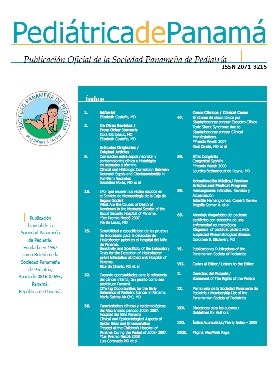Desafío diagnóstico
Autores/as
DOI:
https://doi.org/10.37980/im.journal.rspp.20221954Palabras clave:
Pediatría, Osteomielitis, DrepanocitosisResumen
Proceso actual
Lactante varón de 7 meses valorado por limitación de la movilidad y aumento de volumen de rodilla y muslo derecho de 24 horas de evolución. No otra sintomatología asociada. No antecedentes patológicos de interés. Antecedente de traumatismo contuso en rodilla derecha 5 días previos a su ingreso y cuadro viral respiratorio hace 9 días.
Exploración física
Limitación de la movilidad y aumento de volumen de pierna derecha, caliente no eritematosa. Dolor a la palpación en rodilla y 1/3 inferior de muslo. Pulsos periféricos palpables y simétricos. Resto de extremidades sin hallazgos patológicos.
Pruebas complementarias
Analítica sanguínea: Hb 7.8 g/dL, Hto 23%, Leucocitos 23.8 x 103 u/L (N 58.4%, L 25.9%), plaquetas 183 x 103 u/L. VES 54 mm/h, PCR >9 mg/dL. Radiografía de miembros inferiores normal. Ultrasonido de miembro inferior derecho se descartó derrame articular visualizándose tenues cambios inflamatorios de la grasa subcutánea periarticular.
Evolución
Ante dichos hallazgos se decidió ingreso hospitalario para tratamiento antibiótico con oxacilina y clindamicina. A las 24 horas, crecimiento de bacilo gram negativo en hemocultivo periférico, se cambió antibioterapia, omitiendo oxacilina y añadiéndose al tratamiento ceftriaxona. Se aisló Salmonella enteritidis en hemocultivo de sangre periférica.
Se solicitó electroforesis de hemoglobina: HbA1 86,5%, HbA1c 4,7%, HbA2 3,4%, HbF2,8% y subpoblaciones linfocitarias, normales, descartándose anemia de células falciformes.
¿Cuál sería la sospecha diagnóstica?
- Artritis séptica. Tumor óseo.
- 4. Infarto óseo.
RESPUESTA: Osteomielitis.
Las infecciones osteoarticulares son una causa importante de morbilidad y mortalidad a nivel mundial. Dentro de las infecciones osteoarticulares la osteomielitis es la más frecuente. Esta se define como la inflamación del hueso de origen infeccioso, generalmente unifocal, que afecta a la metáfisis de huesos largos (fémur en el 30% de los pacientes, tibia en el 22% y húmero en el 12%). Predomina en varones en proporción 2:1, y es más frecuente en menores de 5 años [1].
Aunque hasta en el 50% de los casos se produce en pacientes sanos, hay determinadas patologías que predisponen su aparición: entre las que destacan, la prematuridad, heridas y traumatismos, inmunodeficiencias, contacto con animales o personas con tuberculosis y anemia drepanocítica.
La etiología generalmente es bacteriana, por diseminación por vía hematógena, siendo el germen principal el S. aureus en todos los grupos etarios. Sin embargo, existen otros microorganismos causantes en aquellos pacientes con factores de riesgo asociados, como Neisseria meningitidis en pacientes con deficiencia del complemento y Salmonella enteritidis, en niños con drepanocitosis o inmunodeficiencias. Además, hay que tener en cuenta el importante incremento de Kingella kingae como patógeno causante de osteomielitis, siendo en la actualidad la segunda bacteria en frecuencia en lactantes [2].
Destacar en este punto, que a pesar de que la osteomielitis por Salmonella está ampliamente descrita en pacientes con drepanocitosis, la presencia de la misma en pacientes sanos es inusual. Se ha descrito que el estado de portador asintomático tras una infección gastrointestinal podría suponer riesgo de infecciones, no obstante, se debe descartar la presencia de drepanocitosis mediante electroforesis de hemoglobina [3].
Las manifestaciones clínicas son inespecíficas, pudiendo presentar síntomas generales como irritabilidad, especialmente en neonatos y lactantes. La fiebre no siempre está presente, siendo más frecuente en la artritis séptica. Dentro de los síntomas locales destaca el dolor a punta de dedo, disminución de la movilidad de la zona afecta, rechazo a la deambulación o cojera. Debido a la inespecificidad de los síntomas, su diagnóstico en etapas precoces es difícil de realizar, no obstante, dado el riesgo de secuelas permanentes es importante su sospecha clínica [1].
Dentro de las pruebas complementarias, incluimos como pruebas de primera línea, la analítica sanguínea, el hemocultivo y cultivo de las lesiones, la radiografía y ultrasonidos. Se deberá solicitar siempre analítica incluyendo hemograma y reactantes de fase aguda. Los hallazgos más frecuentes son leucocitosis, aumento del VES hasta en el 80-90% de los pacientes y aumento de la PCR. Se deberá extraer hemocultivo y cultivo de la lesión ya que el hemocultivo tiene una rentabilidad inferior al 50%. En relación a las pruebas de imagen, la radiografía simple suele ser normal en los primeros 14 días; a pesar de ello, es imprescindible su realización para descartar otras patologías. La osteopenia y los cambios periósticos suelen ser visibles a partir de los diez días. En la ecografía se podrán observar abscesos subperiósticos en osteomielitis complicadas y derrame articular, aunque no es patognomónico de infección. El gold estándar para el diagnóstico de osteomielitis es la resonancia magnética por su alta sensibilidad y especificidad, ya que permite ver la extensión y localización anatómica de los abscesos. No obstante, dado su menor disponibilidad y la necesidad de sedación en niños pequeños su uso está restringido a aquellos pacientes que presenten evolución tórpida. Otra prueba utilizada con mayor frecuencia es la gammagrafía ósea con Tc 99 siendo la prueba más sensible para la detección de osteomielitis en las primeras 48-72 horas y especialmente útil para descartar multifocalidad [4].
Respecto al tratamiento, ante cualquier sospecha de osteomielitis se deberá ingresar al paciente e iniciar tratamiento antibiótico empírico e intravenoso. La elección del antibiótico dependerá de la edad del paciente, los factores de riesgo y patrón de resistencias que tengamos en el medio. En el caso de los menores de 3 meses, el antibiótico de elección será cloxacilina u oxacilina asociado a cefotaxima o gentamicina. Entre los 3 meses y 5 años se podrá emplear cefuroxima o cloxacilina asociado a cefalosporinas de 3º generación y en mayores de 5 años cloxacilina o cefazolina. En cuanto a la duración del tratamiento no deberá ser inferior a 10-14 días intravenoso y completar al menos 20 días vía oral en casos de osteomielitis no complicada, sin embargo, se deberá individualizar según el microorganismo que se aísle y atendiendo a parámetros clínicos y analíticos, pudiendo ser preciso completar 6 semanas. En el caso clínico que nos atañe la duración del tratamiento deberá ser por un tiempo no inferior a 4-6 semanas [5].
Por último, la indicación de cirugía quedará relegada para los pacientes que requieran biopsia, presenten artritis séptica, que puede estar asociada hasta en el 30%de los casos, complicaciones neurológicas, pacientes que precisen drenaje de abscesos subperiósticos o intraóseos o falta de respuesta a tratamiento antibiótico en 48-72 horas, como ocurrió en nuestro caso [1].
Licencia
Derechos de autor 2022 Infomedic Intl.Derechos autoriales y de reproducibilidad. La Revista Pediátrica de Panamá es un ente académico, sin fines de lucro, que forma parte de la Sociedad Panameña de Pediatría. Sus publicaciones son de tipo gratuito, para uso individual y académico. El autor, al publicar en la Revista otorga sus derechos permanente para que su contenido sea editado por la Sociedad y distribuido Infomedic International bajo la Licencia de uso de distribución. Las polítcas de distribución dependerán del tipo de envío seleccionado por el autor.







